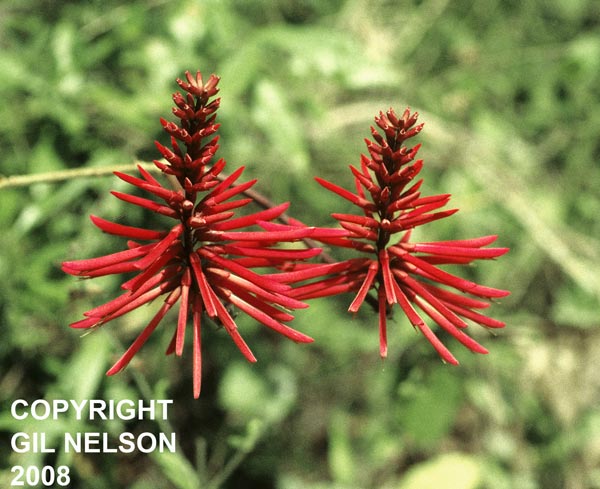Difference between revisions of "Erythrina herbacea"
(→Ecology) |
|||
| Line 43: | Line 43: | ||
Is associated with annually burned pinelands.<ref name=fsu/> | Is associated with annually burned pinelands.<ref name=fsu/> | ||
<!--===Pollination===--> | <!--===Pollination===--> | ||
| − | + | ||
| + | ===Use by animals=== <!--Herbivory, granivory, insect hosting, etc.--> | ||
| + | This species has toxic seeds, which are used in Mexico for poisoning rats and various fish; the seeds are also made into novelties and necklaces which should be kept away from children.<ref name= "lady bird">[[https://www.wildflower.org/plants/search.php?search_field=&newsearch=true]] Lady Bird Johnson Wildflower Center. Accessed: May 10, 2019</ref> | ||
<!--===Diseases and parasites===--> | <!--===Diseases and parasites===--> | ||
Revision as of 17:05, 10 May 2019
| Erythrina herbacea | |
|---|---|

| |
| Photo taken by Gil Nelson | |
| Scientific classification | |
| Kingdom: | Plantae |
| Division: | Magnoliophyta - Flowering plants |
| Class: | Magnoliopsida – Dicotyledons |
| Order: | Fabales |
| Family: | Fabaceae ⁄ Leguminosae |
| Genus: | Erythrina |
| Species: | E. herbacea |
| Binomial name | |
| Erythrina herbacea L. | |

| |
| Natural range of Erythrina herbacea from USDA NRCS Plants Database. | |
Common names: Redcardinal, Coral bean, Cherokee bean, Cardinal-spear
Contents
Taxonomic notes
Synonym: Erythrina arborea (Chapman) Small
Description
"Perennial herb, 0.6-1.2 m tall (or shrub or tree up to 8 m high further south) with usually prickly brachlets. Leaves pinnately 3-foliolate; leatlets thinly chartaceous, glabrous, or nearly so, throughout, occasionally pricky beneath, hastately 3-lobed to widely deltoid, (2) 4-8 (12) cm long, stipellate. Inflorescence terminal, much elongate on usually leafless stems arising from the crown, (1) 3-7 dm long with few to numerous, papilionaceous flowers; pedicels 3-9 mm long, subtended by linear- lanceolate bracts 1-4 mm long and with 2 liner, caduceus bractlets, 1-2 mm long. Calyx glabrous, or nearly so, tubecampanulate, truncate, 5-11 mm long; the standard scarlet, 3-5.3 cm long, wings 5.5-11 mm long, keel 6-13 mm long; stamens diadelphous, 9 and 1; stigma capitate, ovary and stipe pubescent. Legume 7-15 (21) cm long, 1.2-1.6 cm broad, constricted between the several to many, scarlet seeds, stipe 1.5-4.5 cm long." [1]
Distribution
This species is generally distributed from southeast North Carolina south to Florida, west to southeast Texas, and south into eastern Mexico.[2]
Ecology
Habitat
General habitats of E. herbacea includes dry sandy woodlands, maritime forests, and sandhills within the outer Coastal Plain region.[2] It occurs in sand pine woodlands, sandy hills, along edges of sinkholes, live oak-cabbage palm forests, uplands, hammocks, flatwoods, sand pine scrub, pine-palmetto scrub near ocean, longleaf pine-wiregrass savannas, shaded slopes of river bluffs, and in calcareous open prairies. Found in disturbed areas such as along roadsides, in understory of recently clear cut pine woodlands, and edges of woodlands. Can thrive in areas that are shady, semi-shady, or open. Is associated with areas that have sand soil types, sandy loam, loam, thin loamy sand, and calcareous soil types.[3]
Associated species include Quercus geminata, Q. chapmanii, Q. incana, Osmanthus megacarpus, Ilex ambigua, Vitis rotundifolia, Serenoa repens, Persea, Myrica, Carya glabra var. megacarpa, Pinus palutris, Baccharis halimifolia, Rhus copalina, Callicarpa americana, Diospyros virginiana, Morus.[3]
Phenology
E. herbacea generally flowers from May until July.[2] It has been observed flowering from February to June and fruiting from April to August.[3]
Fire ecology
Is associated with annually burned pinelands.[3]
Use by animals
This species has toxic seeds, which are used in Mexico for poisoning rats and various fish; the seeds are also made into novelties and necklaces which should be kept away from children.[4]
Conservation and management
Cultivation and restoration
Photo Gallery
References and notes
- ↑ Radford, Albert E., Harry E. Ahles, and C. Ritchie Bell. Manual of the Vascular Flora of the Carolinas. 1964, 1968. The University of North Carolina Press. 634. Print.
- ↑ 2.0 2.1 2.2 Weakley, A. S. (2015). Flora of the Southern and Mid-Atlantic States. Chapel Hill, NC, University of North Carolina Herbarium.
- ↑ 3.0 3.1 3.2 3.3 Florida State University Robert K. Godfrey Herbarium database. URL: http://herbarium.bio.fsu.edu. Last accessed: June 2014. Collectors: D. B. Ward, G. Crosby, R. Kral, George R. Cooley, Carroll E. Wood, Jr., Kenneth A. Wilson, R.K. Godfrey, Grady W. Reinert, James D. Ray, Jr., C. E. Smith, Olga Lakela, Jackie Patman, Richard J. Eaton, Richard S. Mitchell, Tom Barnes, C. Jackson, A. F. Clewell, Loran C. Anderson, Gary R. Knight, K. Craddock Burks, S. W. Leonard, Elbert L. Little, Jr., Robert J Lemaire, Jack P. Davis, Rodie White, Wilson Baker, R. Komarek, Lisa Keppner, Annie Schmidt, Travis MacClendon, Karen MacClendon, Tim Clemons, R. L. Wilbur, C. Ritchie Bell, Samuel B. Jones, Nancy Coile, et al., Roomie Wilson, Clarke Hudson, Sidney McDaniel, and A Traverse. States and Counties: Florida: Brevard, Calhoun, Citrus, Collier, Dade, Flagler, Franklin, Gadsden, Gulf, Hardee, Indian River, Jackson, Leon, Liberty, Marion, Okaloosa, Pasco, Pinellas, St Lucie, Suwannee, Wakulla, Walton, and Washington. Georgia: Grady and McIntosh. Louisiana: Hammond. Mississippi: Adams, Jasper, and Kemper. South Carolina: Berkeley and Horry. Texas: Harris.
- ↑ [[1]] Lady Bird Johnson Wildflower Center. Accessed: May 10, 2019